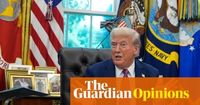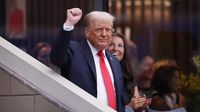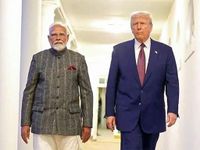The 2025 US Open men’s singles final at Arthur Ashe Stadium in Queens, New York, was always going to be a blockbuster, with tennis titans Jannik Sinner and Carlos Alcaraz squaring off for their third consecutive Grand Slam final showdown. But this year, the drama extended well beyond the baseline, as the appearance of US President Donald Trump set off a wave of both anticipation and controversy, transforming the event into a unique collision of sport, politics, and public sentiment.
Trump, who secured a second term in the White House after a landslide victory over Kamala Harris in the 2024 election, returned to the US Open for the first time since 2015—when, as a presidential candidate, he was famously booed by the New York crowd. This year, his presence was equally polarizing, and the United States Tennis Association (USTA) took extraordinary measures to control the narrative, instructing broadcasters to censor any audible protests or negative reactions that might erupt during the match.
According to internal memos and emails obtained by outlets including The Athletic and Bounces, the USTA’s directive was clear: “We ask all broadcasters to refrain from showcasing any disruptions or reactions in response to the President’s attendance in any capacity,” the association wrote. This guidance was sent to ESPN, Sky Sports, ABC, and other media partners. The USTA further clarified in a statement, “We regularly ask our broadcasters to refrain from showcasing off-court disruptions.”
This wasn’t just a routine request. The USTA’s move came amid fears that Trump, whose approval ratings had dipped to around 40% in recent polls and whose administration faced criticism for foreign policy decisions, reciprocal tariffs, and anti-immigration measures, would be met with a less-than-warm reception in the largely Democratic city of New York. Anticipating a potentially hostile crowd, organizers also ramped up security, resulting in long lines and a delayed start to the final. The match, originally scheduled for 2:00 p.m. ET, was pushed back thirty minutes to accommodate the heightened security measures linked to Trump’s attendance.
When Trump emerged from the Rolex Suite to greet the crowd, the stadium was only about 10 percent full, and no public address announcement accompanied his entrance. Yet, even in the sparsely populated arena, a mix of boos and cheers echoed through the stands—a sign of the divided opinions swirling around the president’s presence. ABC, adhering to the USTA’s wishes, muted the crowd’s reaction on the broadcast, playing music over the scene instead. As the stadium filled, Trump was shown on the jumbotron during Sgt. Maj. Carla Loy’s stirring performance of the national anthem. Boos broke out once again, quickly giving way to applause for Loy’s rendition. Between matches, Trump appeared on the big screen for about twenty seconds, drawing another round of mostly boos and a few whistles from the now-packed house.
The USTA’s attempt to sanitize the event’s atmosphere did not go unnoticed. Critics argued that the move was less about maintaining order and more about shielding Trump from public disapproval—a sharp departure from the Open’s tradition of embracing the unpredictable energy of its fans. As one commentator put it, “The Open is supposed to be New York’s tournament, brash and democratic, rowdy and unfiltered, vibrant and exuberantly multicultural, where the crowd is as much a character as the players on the court. By sanitizing its reaction, the USTA isn’t just shielding Trump. It is stripping the event of its unique character, authenticity, and integrity.”
This year’s final was a showcase not only of elite tennis but also of the cultural and political tensions that have come to define the Trump era. The USTA’s handling of the situation drew comparisons to previous moments when public figures faced the wrath—or adulation—of sports crowds. From UK home secretary Theresa May being booed at the 2012 London Paralympics to French president Emmanuel Macron being whistled at the 2023 Rugby World Cup opening, such moments are often seen as a healthy expression of democracy rather than a threat to civic order. “Crowd dissent on broadcasts is not a breakdown of civic order. It is its expression,” one analysis noted.
Trump’s relationship with the US Open is a long one. Before entering politics, he was a regular fixture at the tournament, reportedly holding a suite for nearly two decades before relinquishing it in 2017, the year he first became president. This year, he returned as a guest of Rolex, the Swiss watchmaker and tournament sponsor. Some observers speculated that Rolex’s invitation may have had an ulterior motive, with the company hoping to lobby Trump on reducing the 39 percent tariff on Swiss imports.
The controversy over crowd censorship was especially pointed given the US Open’s storied history of broadcasting fan disturbances and protests. Just two years ago, the tournament aired a lengthy climate protest during Coco Gauff’s semi-final, and rowdy fan behavior has long been part of the event’s identity. The decision to draw the line at political dissent, particularly against a sitting president, was seen by many as a capitulation rather than a demonstration of policy consistency.
The action on court, meanwhile, was no less compelling. Jannik Sinner, fresh off his Wimbledon triumph, faced off against Carlos Alcaraz, the 2022 US Open champion. Their rivalry, already one for the ages, added another chapter as they battled for Grand Slam supremacy. The women’s tournament also made headlines, with Aryna Sabalenka successfully defending her title by defeating Amanda Anisimova in straight sets earlier in the day, earning a standing ovation from fans and cementing her status as one of the sport’s dominant forces.
As the final unfolded, the tension in the stands mirrored the intensity on the court. For some, Trump’s attendance was a distraction from the tennis; for others, it was a reminder of the sport’s place in the broader cultural conversation. Regardless of political leanings, the day underscored the US Open’s role as a stage not just for athletic excellence, but for the full spectrum of American expression—boos, cheers, and all.
When the dust settles, the 2025 US Open will be remembered for more than just the scoreline. It will be recalled as the year when the boundaries between sport and politics blurred, when the roar of the crowd—whether heard or muted—became as much a part of the story as the clash between Sinner and Alcaraz. In the end, the action on the court continues, but the debate over what should be heard off it lingers on.


